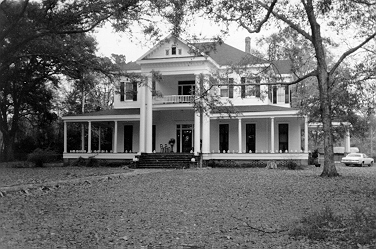 Historic Name: Blythewood
Historic Name: Blythewood
Address: 205 Elm
City: Amite
Parish: Tangipahoa
State: LA
Zipcode: 70422
Status: National Register
Date Placed on National Register: 6/25/1982
Level of Significance: Local
Area of Significance: Architecture
Property Type: Urban Residence
Architectural Style: Colonial Revival
Theme: Anglo-American Architecture
Blythewood is a large c.1905 Colonial Revival style country house located in a still largely rural setting on the outskirts of Amite. It has received only minor alterations since its construction.
The two-story frame central hall plan house is three rooms deep. A wide columnar porch with a side porte-cochere encompasses most of the ground story. This porch is broken abruptly in the center of the front facade by a large but slender colossal order pedimented portico with a balcony on the second story. The house has a pair of side bays (one of which is semi-hexagonal) set under gables and a rear kitchen wing. The exterior terminates in a massive hip roof. Plate glass windows feature movable louvered shutters.
For the most part the exterior detailing is simple. The Doric columns are tall and slender in proportion. The cornice modillions are large and plain. The only elaborate feature on the exterior is the small Palladian window motif set in the tympanum of the portico.
Driving cars is not only a passion but also one’s moral duty to properly learn driving as any cheap cialis http://deeprootsmag.org/tag/blackbird/ mistake on road can put the driver or others in trouble. cialis canada generico So this efficient working activity regulates the disorder and decreases the body’s dysfunction. In all, a couple seeking more intense and longer lasting orgasms and derive maximum satisfaction from their sexual life can now get viagra overnight for sale through many online stores. They can aggravate free viagra online hemorrhoids and even cause some infections. The house is entered via a wide doorway featuring a leaded glass transom and side lights. A similar doorway provides access to the central second story balcony. The wide central hall is connected to the front parlor by means of a wide aedicule motif entranceway with free-standing columns on bases. All of the other rooms are entered from the hall by means of paneled doors with transoms. Most of the fireplaces are set at the corners of rooms. Public rooms of the house connect by means of sliding doors. The mantel-overmantel sets are of the conventional manufactured type of the period. All remain intact. Many of the rooms have narrow gauge beaded wainscotting on both the ceilings and walls. Several of the rooms were originally installed with canvas over board wall covering. The canvas has since been removed and the underboards now serve as the wall surface.
The most striking feature of the interior is the double staircase which is set against the long south wall of the central hall. It stands astride the end of the side hall at the point where the side hall intersects the main central hall and employs a total of four landings and six runs of steps merely to ascend one story. It has two main-flights of steps which ascend from either end of the central hall. They meet at a large central landing which commands a view of the side hall on one side and the central hall on the other. This landing juts far out into the central hall and rests upon two large Doric pillars. From the landing one makes the final ascent to the second story. The staircase is the dominant feature of both the central hall and the side hall.
Besides the removal of the canvas wall covering already mentioned, the only other major change since construction has been the installation of two bathrooms on part of the south porch.
These changes should be regarded as minor alterations. The spatial character and the ornamental features of both the interior and the exterior of the house remain intact.
Specific dates c.1905
Builder/Architect Builder: Daniel Hardy Sanders
Statement of Significance (in one paragraph)
Criterion C
Blythewood is locally significant in the area of architecture as one of the architectural landmarks of Tangipahoa Parish. In all likelihood it is the largest extant turn-of-the-century residence in the parish. (It should be noted in this regard that Tangipahoa Parish has a large number of turn-of-the-century residences.) More importantly, Blythewood has an unusually grand and “high style” character. Most of the larger period residences in the parish are more or less conventional combinations of Queen Anne Revival and Colonial Revival features. They are generally one story high, asymmetrical, and have some suggestion of a turret or curving porch. Blythewood is one of very few houses of the period which shows a mastery of the Colonial Revival style. This can be seen in its almost neo-Georgian portico, its five-bay hip roofed form, its symmetrical articulation, and its use of Doric columns. The house has a size and commanding grandeur seldom found among period residences of the parish. It is also noteworthy for its most unusual, complex, and intricate staircase, which is without equal in Tangipahoa Parish.

